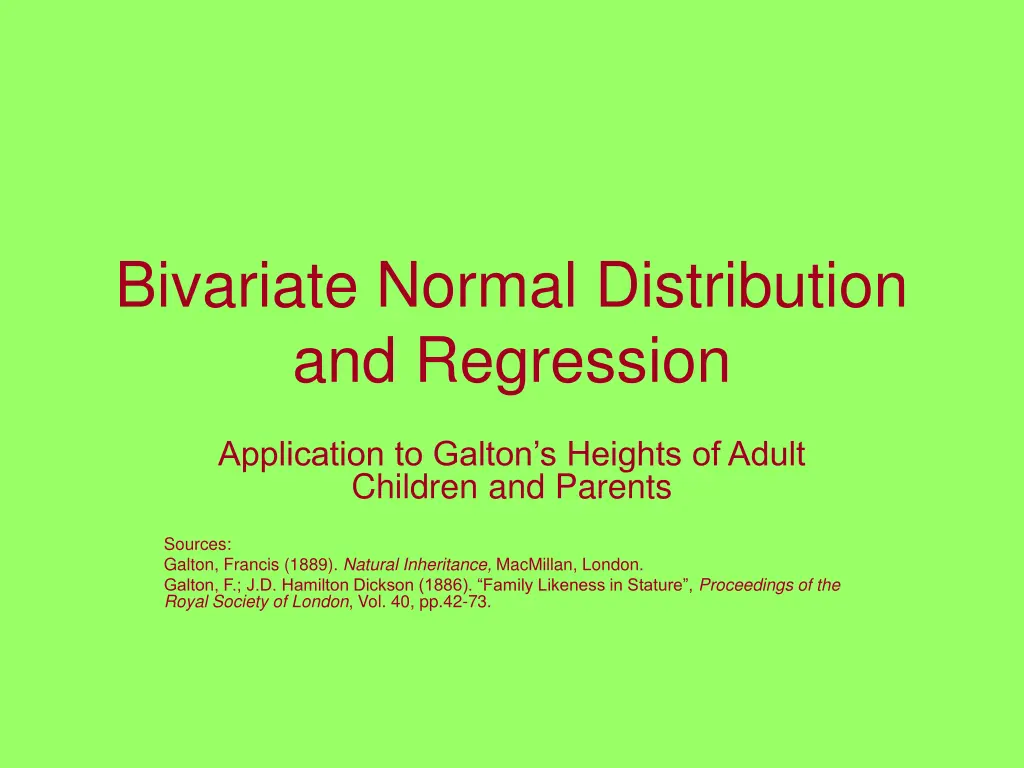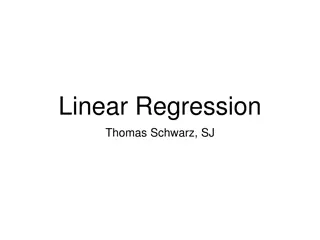
Regression Application to Galton's Heights of Adult Children and Parents
Explore the bivariate normal distribution and regression application to Galton's study on the heights of adult children and parents. Analyze the relationship between adult child and mid-parent heights using data reported by Galton. Visualize the joint density function and marginal distribution to understand the patterns in the data.
Download Presentation

Please find below an Image/Link to download the presentation.
The content on the website is provided AS IS for your information and personal use only. It may not be sold, licensed, or shared on other websites without obtaining consent from the author. If you encounter any issues during the download, it is possible that the publisher has removed the file from their server.
You are allowed to download the files provided on this website for personal or commercial use, subject to the condition that they are used lawfully. All files are the property of their respective owners.
The content on the website is provided AS IS for your information and personal use only. It may not be sold, licensed, or shared on other websites without obtaining consent from the author.
E N D
Presentation Transcript
Bivariate Normal Distribution and Regression Application to Galton s Heights of Adult Children and Parents Sources: Galton, Francis (1889). Natural Inheritance, MacMillan, London. Galton, F.; J.D. Hamilton Dickson (1886). Family Likeness in Stature , Proceedings of the Royal Society of London, Vol. 40, pp.42-73.
Data Heights of Adult Children and Parents Adult Children Heights are reported by inch, in a manner so that the median of the grouped values is used for each (62.2 , ,73.2 are reported by Galton). He adjusts female heights by a multiple of 1.08 We use 61.2 for his Below We use 74.2 for his Above Mid-Parents Heights are the average of the two parents heights (after female adjusted). Grouped values at median (64.5 , ,72.5 by Galton) We use 63.5 for Below We use 73.5 for Above
Adult Child vs Mid-Parent Height 75 74 73 72 71 70 69 Adult Child 68 67 66 65 64 63 62 61 60 63 64 65 66 67 68 69 70 71 72 73 Mid-Parent
Mid-Parent Height 250 200 150 Frequency 100 50 0 63.5 64.5 65.5 66.5 67.5 68.5 69.5 70.5 71.5 72.5 Height
Adult Child Heights 180 160 140 120 100 Frequency 80 60 40 20 0 61.2 62.2 63.2 64.2 65.2 66.2 67.2 68.2 69.2 70.2 71.2 72.2 73.2 74.2 Height
Joint Density Function ( ) ( )( ) ( + ) 2 2 1 1 2 y y y y = ( , ) exp , 1 1 1 1 2 2 2 2 f y y y y ( 1 ) ( 1 ) 1 2 1 2 1 2 2 1 2 2 2 2 1 2 2 2 2 2 Bivariate Normal Density where : = = 2 1 ( ) ( ) E Y V Y 1 1 1 = Y = 2 2 ( ) ( ) E Y V Y 2 2 2 ( )( ) E Y = 1 1 2 2 1 2 0.15-0.2 0.1-0.15 0.05-0.1 0.2 0-0.05 0.15 0.1 0.05 0 -3 -2.5 -2 -1.5 -1 -0.5 0 0.5 1 1.5 2 2.5 3 x1 = = = = =
Marginal Distribution of Y (p. 1) ( ) 1 2 2 , f y y dy ( ) y = f 1 1 ( ) ( )( ) ( + ) 2 2 2 y y y y 1 1 = 1 1 1 1 2 2 2 2 exp dy ( ) ( ) 2 2 1 2 2 2 2 1 2 1 2 2 2 2 1 1 2 = Bringing out constant (temporarily) and forming common denominator in ex pone nt: 1 1 ( ) ( )( ) ( ) 2 2 = + 2 2 2 exp 2 y y y y dy ( ) ( ) 1 1 1 1 2 2 1 2 2 2 1 2 2 2 1 2 2 2 1 2 1 2 2 2 1 2 ( ) 2 2 2 2 Completing the square in the exponent by adding and subtracting in the square brackets: y 1 1 1 = ( ) 2 1 2 2 2 2 1 1 ( ) ( )( ) ( ) ( ) ( ) 2 2 2 2 + + 2 2 2 2 2 2 2 2 2 exp 2 y y y y y y dy ( ) 1 1 1 1 2 2 1 2 2 2 1 1 1 1 1 2 2 2 1 2 2 2 1 1 = ( ) 2 1 2 2 2 2 1 1 ( ) ( ) ( )( ) ( ) ( ) 2 2 2 + + 2 2 2 2 1 2 2 2 exp 2 1 y y y y y dy ( ) 1 1 1 1 2 2 1 2 2 2 1 1 2 2 2 1 2 2 2 1
Marginal Distribution of Y (p. 2) Pulling out term not involving and cleaning up exponents: y 2 ( ) ( ) ( ) ( ( ) 2 2 2 2 2 1 y y y 1 ( ) y 1 1 2 2 1 1 1 2 2 2 = exp exp f dy ( ) ) ( ) 1 1 2 2 2 1 2 2 2 2 1 2 1 2 1 2 1 2 2 2 2 1 2 ( ) ( ( 2 1 ) y y 2 ( ) 2 2 2 1 1 y 1 = 1 1 1 exp exp dy ) ( ) 2 2 1 2 2 2 2 2 1 2 2 2 2 1 2 ( ) + y y 2 ( ) 2 2 2 1 1 y 1 1 = 1 1 exp exp dy ( ) ( ) 2 2 1 2 2 2 2 2 1 2 1 2 2 2 2 1 ( 2 V Y ) E Y ( ) = + = 2 2 2 The integ rand is proportional to a normal density with: 1 y 2 2 2 1 1 1 Taking the normalizing constant from the constant in front gives us: 2 ( ) + y y 2 ( ) ( ) 2 2 2 2 1 1 y y 1 1 1 ( ) y 1 = = 1 1 1 1 exp exp exp f dy ( ) ( ) 1 1 2 2 1 2 1 2 2 2 2 2 2 1 2 1 2 1 2 2 2 2 2 2 1
Conditional Distribution of Y2 Given Y1=y1 (P. 1) ( ) ( ) ( ) 2 1 1 , y f y y ( ) = = | 1 2 f y y 2 1 f 1 1 ( )( ) ( + ) 2 2 1 1 2 y y y y exp 1 1 1 1 2 2 2 2 ( 1 ) ( 1 ) 1 2 2 1 2 2 2 2 2 2 2 2 ( ) 2 y exp 1 1 2 1 2 2 1 2 ( ) ( )( ) ( + ) ( ) 2 2 2 1 1 2 1 y y y y y = + exp 1 1 1 1 2 2 2 2 1 1 ( 1 ) ( 1 ) 1 2 2 1 2 2 2 1 2 2 2 2 2 2 2 ( 1 ) ( ) 2 2 Putting terms involving together by multiplyin g and dividing last term by : y 1 1 ( 1 ( 1 ) ) ( ) ( )( ) ( + ) 2 2 2 1 2 1 1 2 y y y y = exp 1 1 1 1 2 2 2 2 ( 1 ) ( 1 ) 1 2 2 2 2 2 2 2 2 2 ( ) ( )( ) ( + ) 2 2 2 1 1 2 y y y y = exp 2 2 1 1 2 2 1 1 ( 1 ) ( 1 ) 1 2 2 2 2 1 2 2 2 2 2 2
Conditional Distribution of Y2 Given Y1=y1 (P. 2) 2 2 Pulling out in the denominato r of the exponent, then forming the " perfect square" then , function a of : y 2 ( )( ) ( + ) 2 1 2 2 2 2 1 1 2 y y y ( ) 2 = exp 2 1 1 2 2 1 1 y ( 1 ) ( 1 ) 2 2 2 2 2 2 2 2 2 2 1 ( ) 2 1 1 y ( ) = exp 1 1 2 y ( 1 ) ( 1 ) 2 2 2 2 2 2 2 2 2 2 1 2 ( ) 1 1 y = + exp 1 1 2 y ( 1 ) ( 1 ) 2 2 2 2 2 2 2 2 2 2 1 ( ) ( 1 ) y = + 2 2 2 | ~ , 1 1 2 Y Y y N 2 1 1 2 1 This is referred to as the REGRESSION of Y2 on Y1
Summary of Results Joint Distribution: ( ) ( )( ) ( + ) 2 2 2 y y y y 1 1 = 1 1 1 1 2 2 2 2 ( , f y y ) exp , y y ( ) ( ) 1 2 1 2 2 1 2 2 2 2 1 2 1 2 2 2 2 1 1 2 Marginal (aka Unconditional) Distributions: = = ( ) 2 y 1 ( ) y 1 1 exp f y 1 1 1 2 1 2 2 1 2 ( ) 2 y 1 ( ) 2 2 exp f y y 2 2 2 2 2 2 2 2 2 ( ) ( ) 2 1 2 2 ~ , ~ , Y N Y N 1 1 2 2 Conditional Distributions: 2 ( ) y 1 1 ( ) = + 1 1 2 | exp f y y y y ( ) ( ) 2 1 2 2 2 2 2 2 2 1 2 2 2 2 1 1 2 ( ) y 1 1 ( ) = + 2 2 1 | e xp f y y y y ( ) ( ) 1 2 1 1 1 2 2 1 2 1 2 1 2 2 1 ( 2 ) ( ) y y ( ) ( ) = + = + 1 1 2 2 2 1 2 2 2 2 1 2 | ~ , 1 | ~ , 1 Y Y y N Y Y y N 2 1 1 2 1 2 2 1 1 2
Heights of Adult Children and Parents Empirical Data Based on 924 pairs (F. Galton) Y2= Adult Child s Height Y2 ~ N(68.1,6.39) 2=2.53 Y1 = Mid-Parent s Height Y1 ~ N(68.3,3.18) 1=1.78 COV(Y1,Y2) = 2.02 = 2 = 0.20 Y2|Y1=y1is Normal with conditional mean and variance: ( ) ( ) . 3 1 = = = = Y y Y Y V 68 3 . . 0 ( 45 ) . 6 39 y y = = + = + = + = + | 68 1 . 68 1 . . 0 638 43 6 . 24 5 . . 0 638 1 1 2 1 E Y Y y y y 2 1 1 2 1 1 18 ( 1 ) = = 2 2 2 | . 6 39 1 ( 20 . ) . 5 11 . 5 11 . 2 26 2 1 1 2| y 1 Unconditional y1 E[Y2|y1] Y2|y1 63.5 65.0 2.26 66.5 66.9 2.26 69.5 68.8 2.26 72.5 70.8 2.26 68.1 2.53
Joint Density Function 0.035-0.04 0.03-0.035 0.025-0.03 62.96 0.02-0.025 0.04 64.206 0.015-0.02 0.035 0.01-0.015 65.452 0.005-0.01 0.03 66.698 0-0.005 0.025 67.944 y1 0.02 69.19 0.015 70.436 0.01 71.682 0.005 72.928 0
Joint Density Function 0.035-0.04 0.03-0.035 0.025-0.03 62.96 0.02-0.025 64.206 0.015-0.02 0.04 65.452 0.01-0.015 0.035 0.005-0.01 66.698 0.03 0-0.005 67.944 0.025 y1 0.02 69.19 0.015 70.436 0.01 71.682 0.005 72.928 0
Distributions of Heights of Adult Children 0.2 0.18 0.16 0.14 0.12 uncond y1=63.5 y1=66.5 y1=69.5 y1=72.5 f(y2) 0.1 0.08 0.06 0.04 0.02 0 59.5 60.5 61.5 62.5 63.5 64.5 65.5 66.5 67.5 68.5 69.5 70.5 71.5 72.5 73.5 74.5 75.5 76.5 y2
E(Child)= Regression to the Mean Parent+constant 72.5 71.5 Galton s Finding 70.5 69.5 E(Child) independent of parent 68.5 E(Y2|y1)=24.5+.638y1 E(Y2|y1)=0.21+y1 E(Y2|y1)=E(Y2) E(Y2) 67.5 66.5 65.5 64.5 63.5 63.5 64.5 65.5 66.5 67.5 68.5 69.5 70.5 71.5 72.5 y1
Expectations and Variances E(Y1) = 68.3 V(Y1) = 3.18 E(Y2) = 68.1 V(Y2) = 6.39 E(Y2|Y1=y1) = 24.5+0.638y1 EY1[E(Y2|Y1=y1)] = EY1[24.5+0.638Y1] = 24.5+0.638(68.3) = 68.1 = E(Y2) V(Y2|Y1=y1) = 5.11 EY1[V(Y2|Y1=y1)] = 5.11 VY1[E(Y2|Y1=y1)] = VY1[24.5+0.638Y1] = (0.638)2 V(Y1) = (0.407)3.18 = 1.29 EY1[V(Y2|Y1=y1)]+VY1[E(Y2|Y1=y1)] = 5.11+1.29=6.40 = V(Y2) (with round-off)






